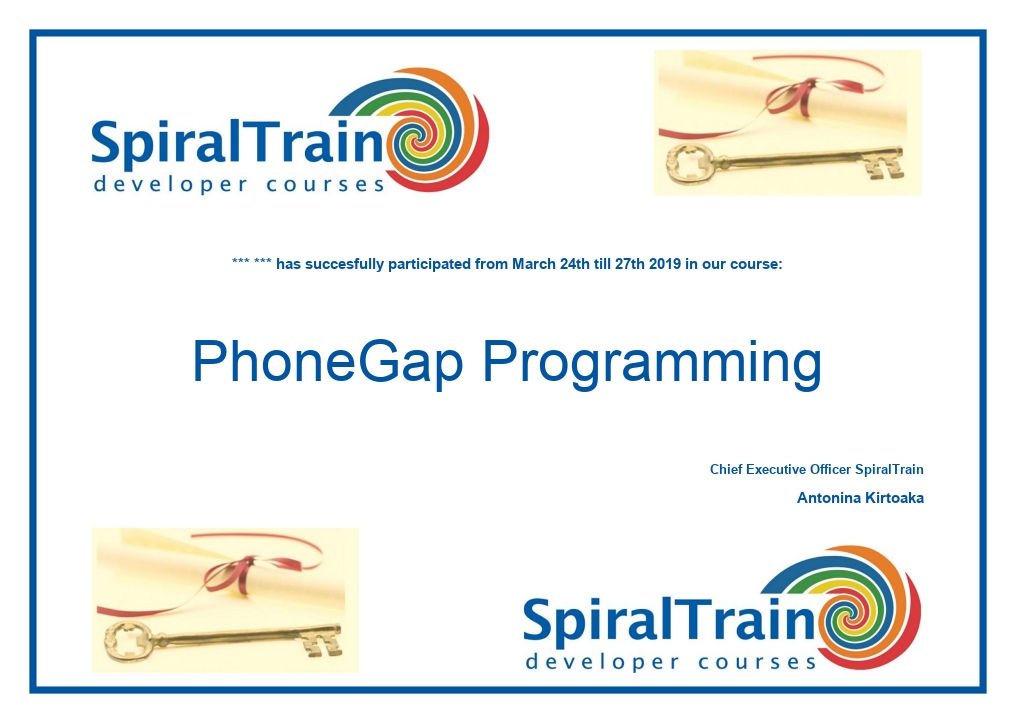-
Learning by doing
-
Trainers with practical experience
-
Classroom training
-
Detailed course material
-
Clear content description
-
Tailormade content possible
-
Training that proceeds
-
Small groups
In the course PhoneGap Programming the participants learn to create cross-platform mobile applications using the open-source framework PhoneGap.
The course PhoneGap programming starts by explaining how PhoneGap allows you to build mobile apps while adding re-use to your code and other assets using well known web technologies like HTML, CSS and JavaScript. Attention is paid to setting up the development environment to compile for multiple platforms and to run and debug the HTML and JavaScript.
Also covered is how PhoneGap Build can be used to create app-store-ready applications for iOS and Android. Deployment and installation of the application on devices like a smart phone or tablet is treated as well.
And the optimization of JavaScript for mobile devices, the use of CSS transitions, animations and transformations to create native looking interfaces is on the course schedule. And the use of mobile JS libraries, such as XUI and Dashcode to build mobile applications faster is covered.
Finally it is discussed how to access native APIs, including location, camera, accelerometer, contacts and more via JavaScript.
The course PhoneGap Programming is designed for web developers, mobile developers and designers and project managers in mobile projects who want to learn about cross-platform programming with PhoneGap.
Knowledge and experience with HTML, CSS and JavaScript and the mobile ecosystem is required to participate in the course PhoneGap Programming.
The subjects are discussed on the basis of presentation slides. Demos help to clarify the concepts further. The theory is interspersed with exercises. Mobile devices are emulated in the Eclipse IDE. The course material is in English.
After successful completion of the course, participants receive an official certificate PhoneGap Programming.

Module 1 : Cross Platform Development |
Module 2 : PhoneGap Essentials |
Module 3 : PhoneGap Build |
| What is Phonegap? Cross-Platform Development jQuery jQuery Mobile AJAX and JSON Local Storage App Navigation Techniques Initializing PhoneGap Native or HTML |
PhoneGap Walkthrough Apache Cordova Adobe PhoneGap Build Accounts Page Model Developing in Browser Writing PhoneGap-Only Code Using PhoneGap APIs Detecting Devices Navigation |
What is PhoneGap Build Eclipse with Plug-Ins Running Android Simulators Building your first App Deploying on an Android Viewing Console with Android SDK What about Icenium? Optional Apple Mac setup in XCode Why not use PhoneGap Build? |
Module 4 : Mobile Projects |
Module 5 : Developing for iOS |
Module 6 : Developing for Android |
| Mobile Projects Creating a new project Importing a boiler-plate project Enabling PhoneGap for Projects What are Signing Certificates? What is Provisioning? Obtaining Certificates Using Signing Certificate Keys Uploading for Certification |
Workflow of iOS Development Apple Developer program Getting a Developer Account Preparing the Mac Provisioning a Device Building a Development IPA Building a Distribution IPA Submitting to the AppStore Signup for Google Play |
Android Developer keys Register Your App Signing Your App Upload to Google Play Kindle Android Store Registering with the Store Testing Your App Why not PhoneGap Build? Building the Project |
Module 7 : Developing for Windows |
Module 8 : Mobile Coding Techniques |
Module 9 : Miscellaneous Topics |
| Windows Phone 8 emulators Windows keys Ripple Emulator in Chrome Free Microsoft tools for Windows 8 Adding a Privacy Policy Submitting to the Store |
Mobile Coding Techniques Writing Optimised Javascript Working with WinJS Code Managing memory on mobiles CSS Optimisations User-Interface best practices |
Accessing Native APIs When to go native Geolocation Camera Accelerometer Other device-specific APIs |
